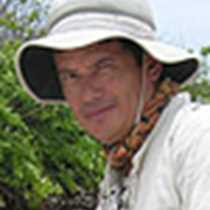Española Island
Located at the souththernmost position in the archipelago, Española is the oldest island and has very few obviously volcanic features. Compared with other islands, Española lacks of hills and tuff cones because of millions of years of erosion. Incredibly in this barren landscape without fresh water, this island hosted a very large colony of introduced feral goats; of course they could survive here drinking sea water.
Early in the morning, our activities began with an exciting kayaking along the Gardner islet. From the kayaks our guests could appreciate the remains of an ancient volcano, paddling into its caldera that nowadays is a bay with calm waters. Galápagos sea lions were our companions, swimming and playing with us like inviting us to swim with them.
After breakfast we headed to Gardner Bay’s beach. From the distance, its sand looked brilliant white in contrast with the black bodies of sea lions laying on it. The disembarkation was a little bit complicated because the sea was very rough, but after landing on the beach, all was different. We had opportunity to take photos of many sea lions and mockingbirds walking just in front of us or looking for our bottles of water.
In the afternoon we visited Punta Suarez. As soon we got there, a group of marine iguanas laying on the rocks showed us their red color, with some finches cleaning their skin of parasites. Walking inland, next to the iguanas’ territory, we observed a group of blue footed boobies’ chicks, other incubating eggs or other solitaries decorating their nests with small twigs. Their unmistakable noise was heard at the distance, while we headed to the albatrosses area.
Our guests walked slowly but anxiously to visit and see the largest bird in Galápagos. And finally, that magnificent creature appeared in front of us. During the first observation, we checked many juveniles with their grey plumage, blending with the dry vegetation. The majority of them weren’t without their parents, and the reason was very obvious, they are fishing for feeding those huge birds, hasten their activities because they know that they have to abandon the island at the latest in January, because the temperature will increase considerably, impossible for this bird which adaptation is better in cool weathers. We talked about their migration and the incredible way they come back to this small island, a spot in the huge Pacific Ocean.
We walked and stopped for many minutes in front of the blowhole. This natural formation captivated our eyesight. We were seeing hawks, boobies, gulls, frigatebirds and albatrosses flying above us, when suddenly a group of swallow tailed gulls that were on the rocks began to fly hastily. A Galápagos hawk ambushed them wanting to hunt some of them.
We waited awhile, but the patient hawk still was waiting them to get tired. We walked back and watched as the sunset was coming. We finished our last visit to Galápagos, tired and very happy with the memories of the innocent creatures we have just finished seeing.




